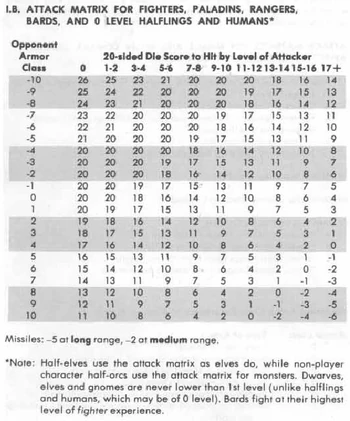(Adding categories) |
No edit summary |
||
| Line 2: | Line 2: | ||
'''THAC0''' means "To-Hit Armor Class 0", and depending on who you ask, it was ether pronounced "thack-oh" or "thay-ko". This was the system used to determine ones to-hit score in the pre-third edition rules. |
'''THAC0''' means "To-Hit Armor Class 0", and depending on who you ask, it was ether pronounced "thack-oh" or "thay-ko". This was the system used to determine ones to-hit score in the pre-third edition rules. |
||
| − | In older rule systems, Armor Class started at 9 (or 10 in ''Advanced Dungeons & Dragons'') for an unarmored person, and progress downwards with better armor protection and high Dexterity, until it reached 0, then it would progress into the negative numbers. Normally, to-hit was determined by referencing the attacker's class/level (or hit dice for monsters) against the defender's AC on a to-hit chart (see image). As listing a to-hit array on individual monster entries was not feasible, THAC0 was used as a shorthand. |
+ | In older rule systems, [[Armor Class]] started at 9 (or 10 in ''Advanced Dungeons & Dragons'') for an unarmored person, and progress downwards with better armor protection and high Dexterity, until it reached 0, then it would progress into the negative numbers. Normally, to-hit was determined by referencing the attacker's class/level (or hit dice for monsters) against the defender's AC on a to-hit chart (see image). As listing a to-hit array on individual monster entries was not feasible, THAC0 was used as a shorthand. |
THAC0 was a means to note what one would need to hit a target with an AC of 0, with positive AC scores (e.g. 10 to 1) subtracting from the THAC0 score, and negative AC scores (-1 to -10) adding to the THAC0 score. So, if a low-level Fighter with a THAC0 of 19 fires an arrow at an Orc with an AC of 7, the players needs to roll a (19 - 7) 12 or more on a d20 to hit. |
THAC0 was a means to note what one would need to hit a target with an AC of 0, with positive AC scores (e.g. 10 to 1) subtracting from the THAC0 score, and negative AC scores (-1 to -10) adding to the THAC0 score. So, if a low-level Fighter with a THAC0 of 19 fires an arrow at an Orc with an AC of 7, the players needs to roll a (19 - 7) 12 or more on a d20 to hit. |
||
Revision as of 22:15, 7 May 2018

An old To-Hit Chart form the first edition Dungeon Master Guide
THAC0 means "To-Hit Armor Class 0", and depending on who you ask, it was ether pronounced "thack-oh" or "thay-ko". This was the system used to determine ones to-hit score in the pre-third edition rules.
In older rule systems, Armor Class started at 9 (or 10 in Advanced Dungeons & Dragons) for an unarmored person, and progress downwards with better armor protection and high Dexterity, until it reached 0, then it would progress into the negative numbers. Normally, to-hit was determined by referencing the attacker's class/level (or hit dice for monsters) against the defender's AC on a to-hit chart (see image). As listing a to-hit array on individual monster entries was not feasible, THAC0 was used as a shorthand.
THAC0 was a means to note what one would need to hit a target with an AC of 0, with positive AC scores (e.g. 10 to 1) subtracting from the THAC0 score, and negative AC scores (-1 to -10) adding to the THAC0 score. So, if a low-level Fighter with a THAC0 of 19 fires an arrow at an Orc with an AC of 7, the players needs to roll a (19 - 7) 12 or more on a d20 to hit.
The first official use of "THAC0" was in the Alphabetical Monster Listing (Appendix E, page 196) in the first edition AD&D Dungeon Master Guide, but its use in second edition Advanced Dungeons & Dragons monster stats that made the term more iconic to that edition.
Due to the confusing and counter-intuitive nature of the old to-hit system, Wizards of the Coast discontinued it during the development of the third edition Dungeons & Dragons game. Since then, AC 10 (unarmored person of average Dexterity) become the standard medium for factoring to-hit scores.